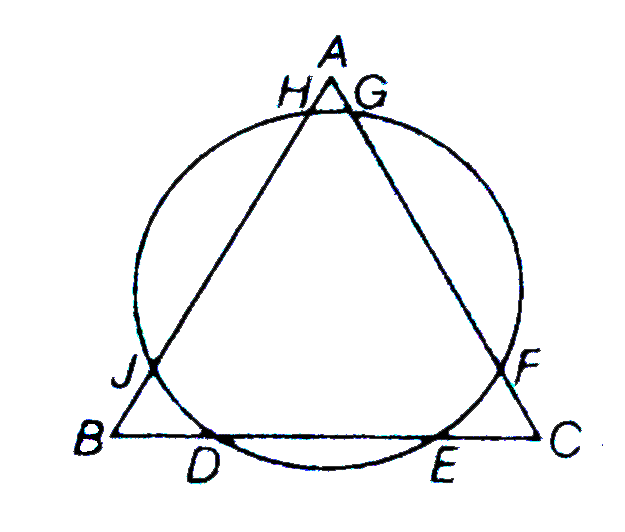In a triangle a=√5,b=2,∠A=π6 and the two possible values of third side are c1andc2, thenSolution in Punjabi
|c1−c2|=2√6
|c1−c2|=4√6
|c1−c2|=4
|c1−c2|=6
The correct Answer is:C
Step by step video & image solution for In a triangle a = sqrt5,b = 2, /_A=pi/6 and the two possible values of third side are c_1 and c_2, then by Maths experts to help you in doubts & scoring excellent marks in Class 12 exams.
Updated on:21/07/2023Topper's Solved these Questions
- PROPERTIES AND SOLUTION OF TRIANGLES BOOK - ARIHANT MATHSCHAPTER - PROPERTIES AND SOLUTION OF TRIANGLES EXERCISE - Exercise (More Than One Correct Option Type Questions)
24 Videos
- PROPERTIES AND SOLUTION OF TRIANGLES BOOK - ARIHANT MATHSCHAPTER - PROPERTIES AND SOLUTION OF TRIANGLES EXERCISE - Exercise (Statement I And Ii Type Questions)
15 Videos
- PROPERTIES AND SOLUTION OF TRIANGLES BOOK - ARIHANT MATHSCHAPTER - PROPERTIES AND SOLUTION OF TRIANGLES EXERCISE - PROPERTIES AND SOLUTIONS OF TRIANGLES EXERSISE 1: SINGLE OPTION CORRECT TYPE QUESTIONS
1 Videos
- PRODUCT OF VECTORSBOOK - ARIHANT MATHSCHAPTER - PRODUCT OF VECTORSEXERCISE - Exercise (Questions Asked In Previous 13 Years Exam)
52 Videos
- SEQUENCES AND SERIESBOOK - ARIHANT MATHSCHAPTER - SEQUENCES AND SERIESEXERCISE - Exercise (Questions Asked In Previous 13 Years Exam)
38 Videos
Similar Questions
If area of ΔABC(Δ) and angle C are given and if c opposite to given angle is minimum, then
View SolutionIn a triangle ABC,a3+b3+c3=c2(a+b+c) (All symbol used have usual meaning in a triangle.) Statement-1: The value of ∠C=60∘. Statement-2: ΔABC must be equilateral.
View SolutionIn the adjoining figure, the circle meets the sides of an equilateral triangle at six points.

If AG=2,GF=13,FC=1andHJ=7, then DE equals to
View SolutionLet O be the origin and let PQR be an arbitrary triangle. The point S is such that ¯¯¯¯¯¯OP⋅¯¯¯¯¯¯OQ+¯¯¯¯¯¯OR⋅¯¯¯¯¯¯OS=¯¯¯¯¯¯OR⋅¯¯¯¯¯¯OP+¯¯¯¯¯¯OQ⋅¯¯¯¯¯¯OS=¯¯¯¯¯¯OQ⋅¯¯¯¯¯¯OR+¯¯¯¯¯¯OP⋅¯¯¯¯¯¯OS Then the triangle PQR has S as its
View SolutionLet a,b,c be in A.P. and |a|<1,|b|<1|c|<1.ifx=1+a+a2+....to ∞,y=1+b+b2+....to ∞and,z=1+c+c2+...to ∞, then x,y,z are in
View SolutionIn an ambiguoa ambiguous case of solving a triangleshen a=sqrt(5),b=2,/_A=(pi)/(6) and the two possible values of third side are c_(1) and c_(2), then
View SolutionIf a,b, A are given in a triangle and c1and c2 are two possible values of third side such that c21+c1c2+c22=a2 , then A is equal to 300 (b) 600 (c) 900 (d) 1200
View Solutionउस त्रिभुज की रचना सम्भव है जिसकी दो भुजाओं का योग तीसरी भुजा के बराबर हो ।
View SolutionTwo sides of a triangle are 2√2cm and 2√3cm. The angle opposite to the shorter side is π4. The largest possible length of the third side is
View Solutionएक त्रिभुज को हल करने पर जब a=√5,b=2,∠A=π6 तथा तीसरी भुजा के दो संभव मान c1 तथा c2 है, तब
View SolutionIn a triangle ABC, two sides a, b and an angle A are given and if two possible values of the third side are given. c_(1) and c_(2) If so
View SolutionIn an ambiguous case of solving a triangle when a=√5b=2,∠A = pi/6 and the two possible values of third side are c1andc2 then
View SolutionIn an ambiguoa ambiguous case of solving a triangleshen a=√5,b=2,∠A=π6 and the two possible values of third side are c1andc2, then
View SolutionIf a,b,A be given in a triangle and c1andc2 be two possible value of the third side such that c21+c1c2+c22=a2, then a is equal to
View SolutionWhen any two sides and one of the opposite acute are given, under certain additional condition two triangle are possible. The case when two triangle are possible is called the ambiguous case.
In fact when any two sides and the angle opposite to one of them are given either no triangle is possible or only one triangle is possible or two triangle are possible.
In the ambiguous case, let a, b, and angleA are given and c_1,c_2 are two values of the third side c.
Two different triangle are possible when
View Solution
